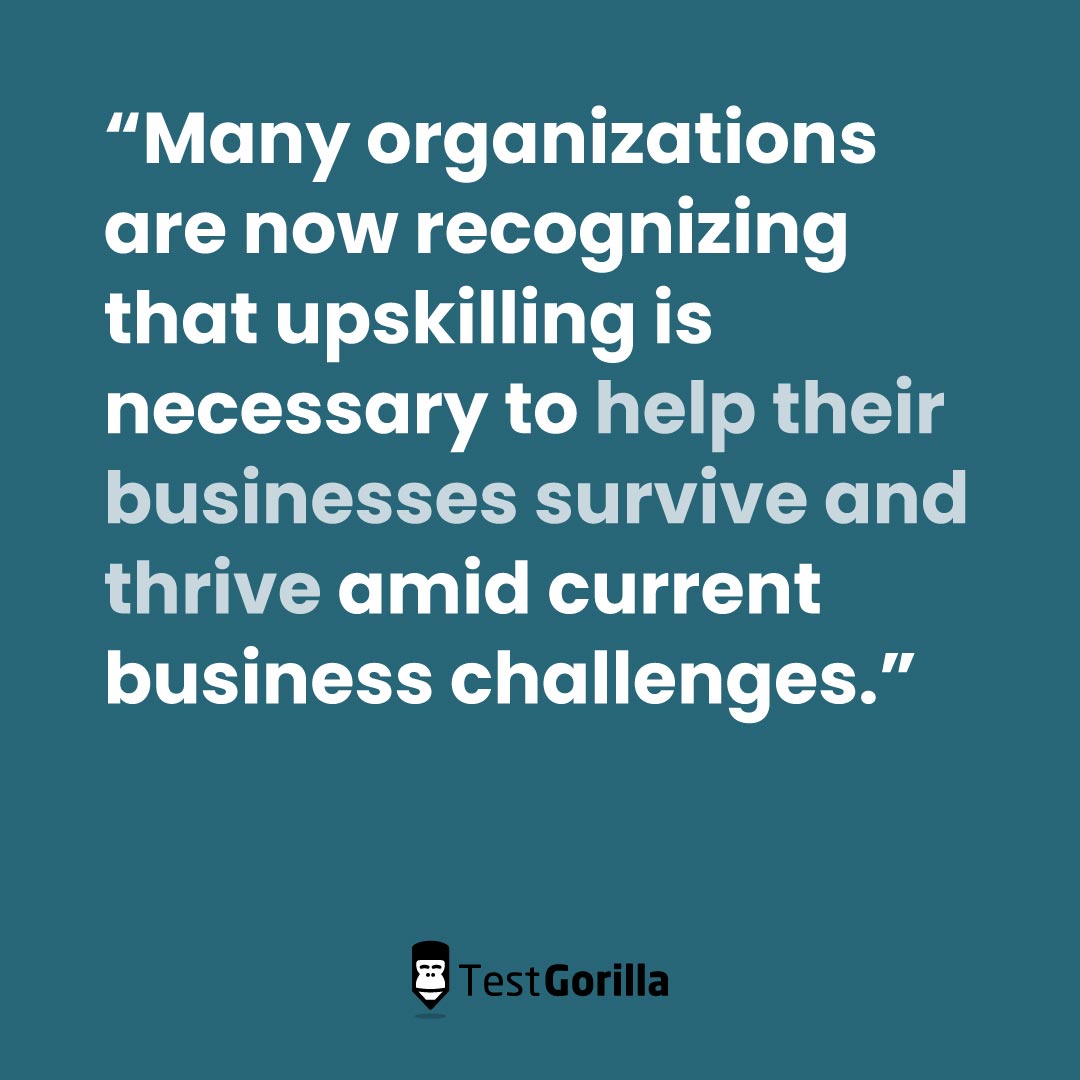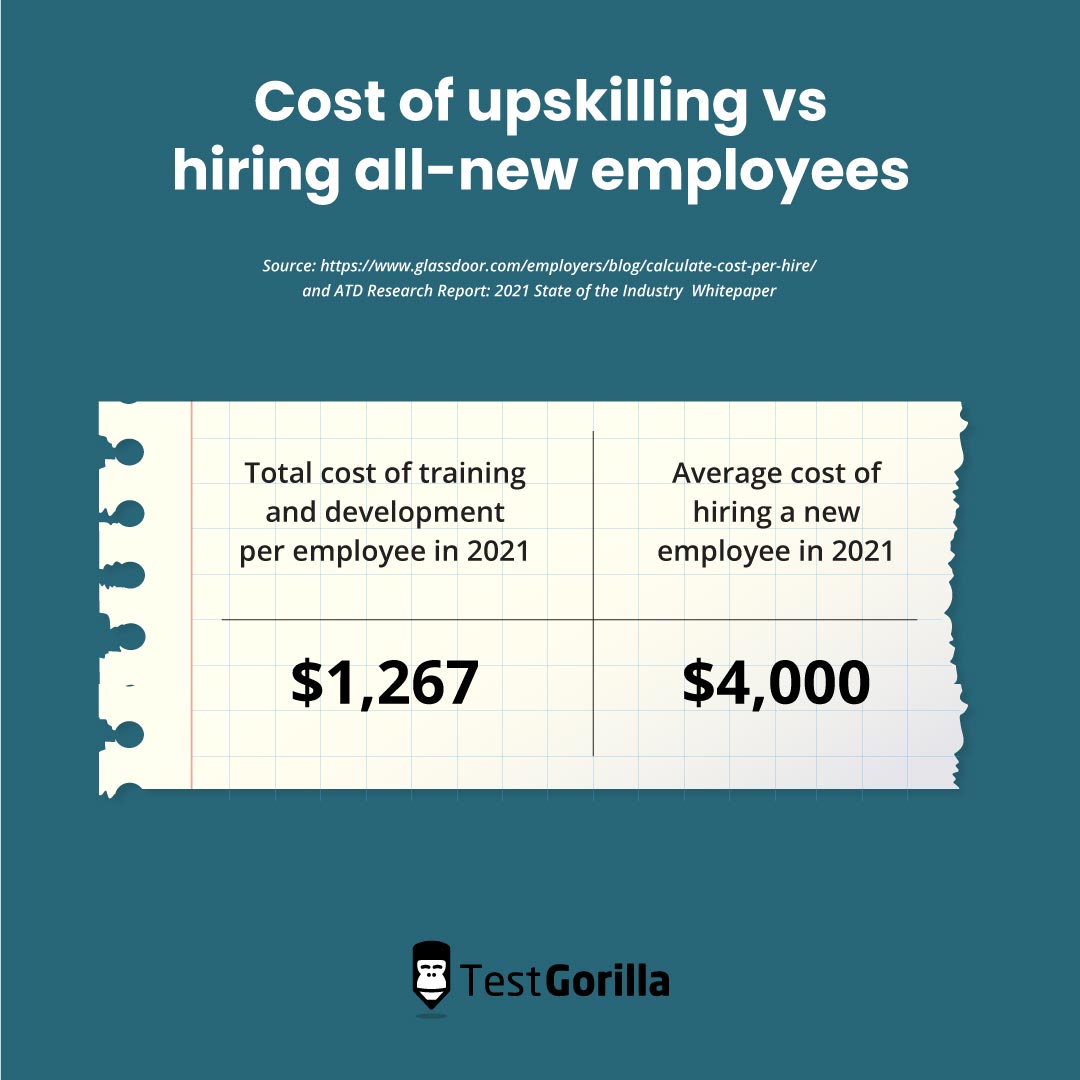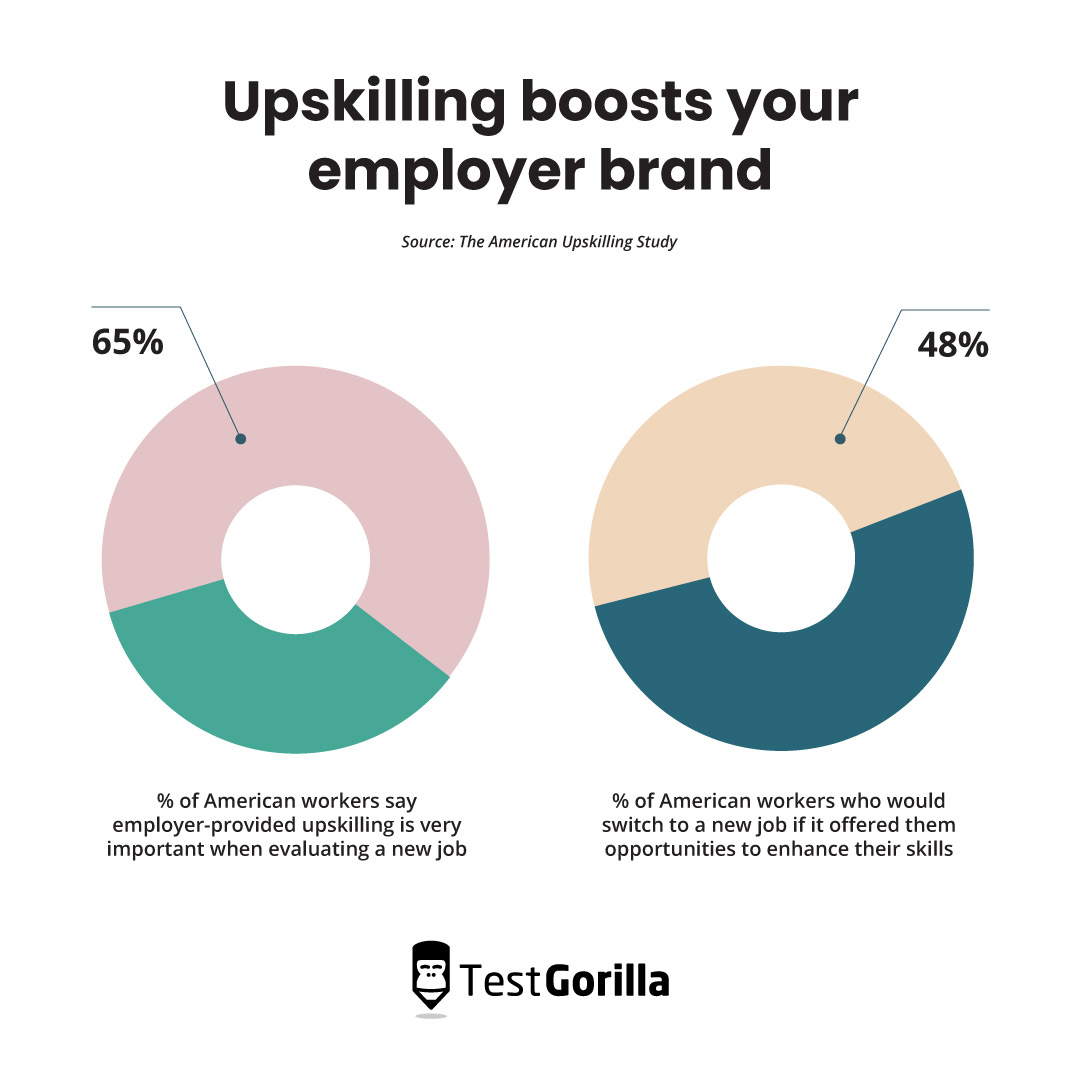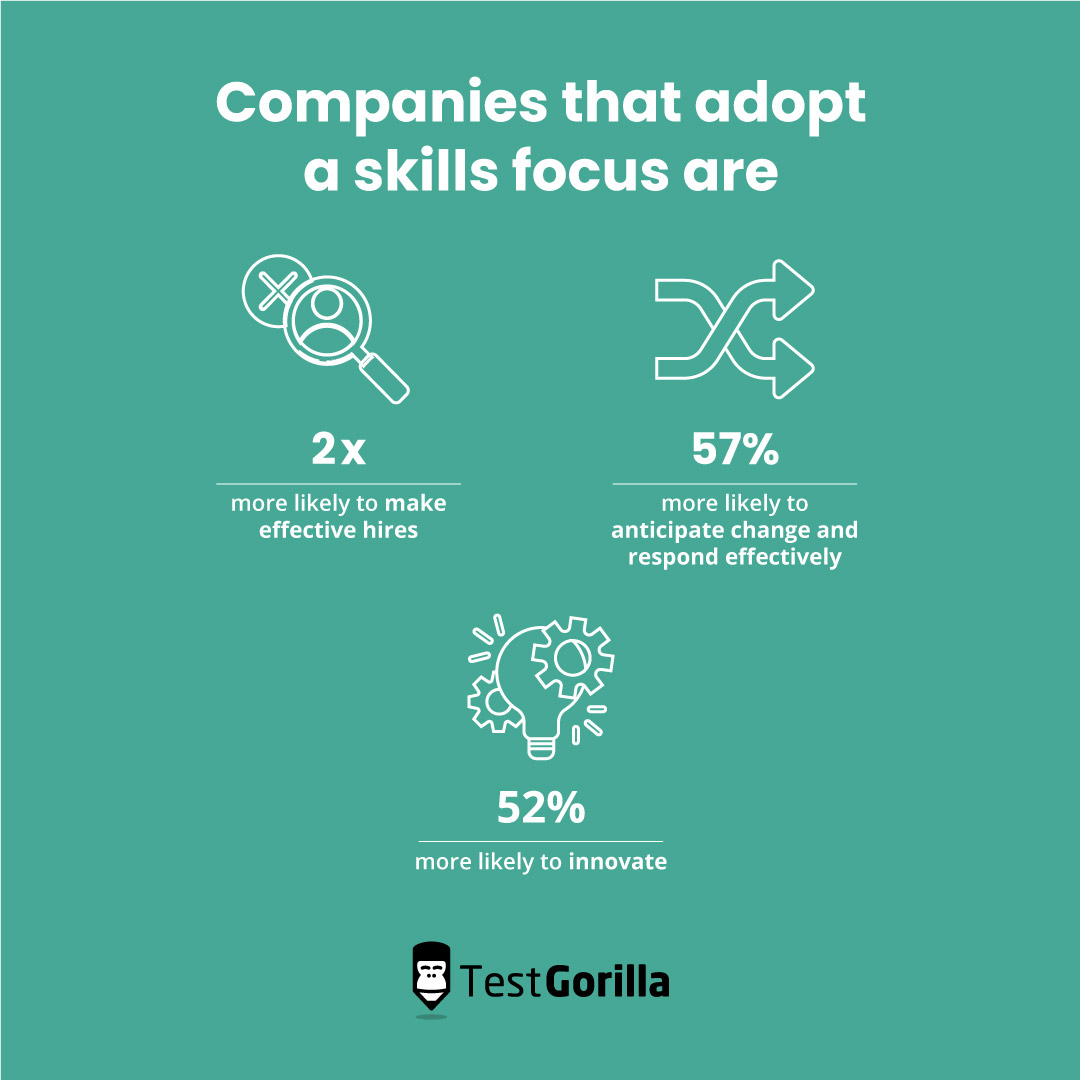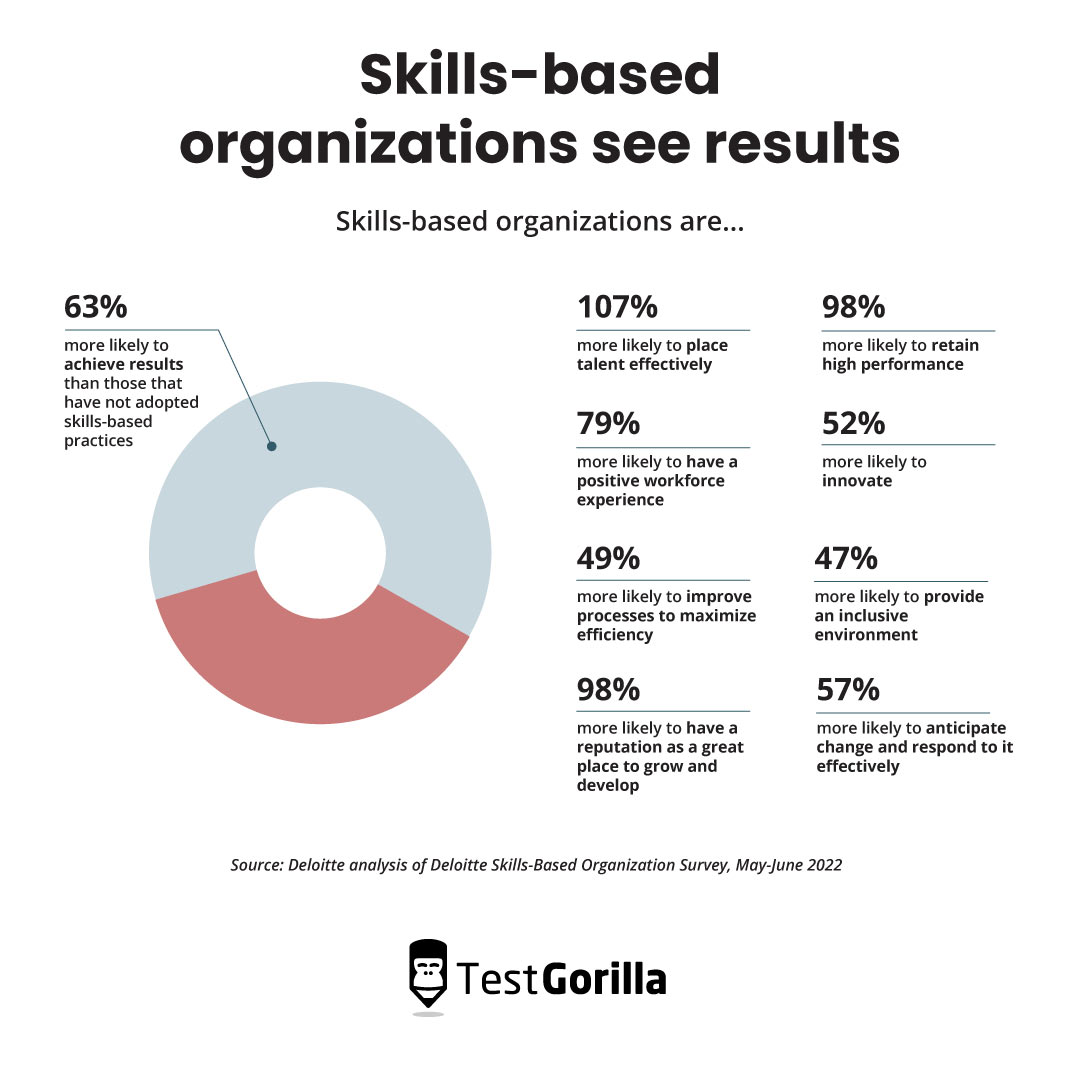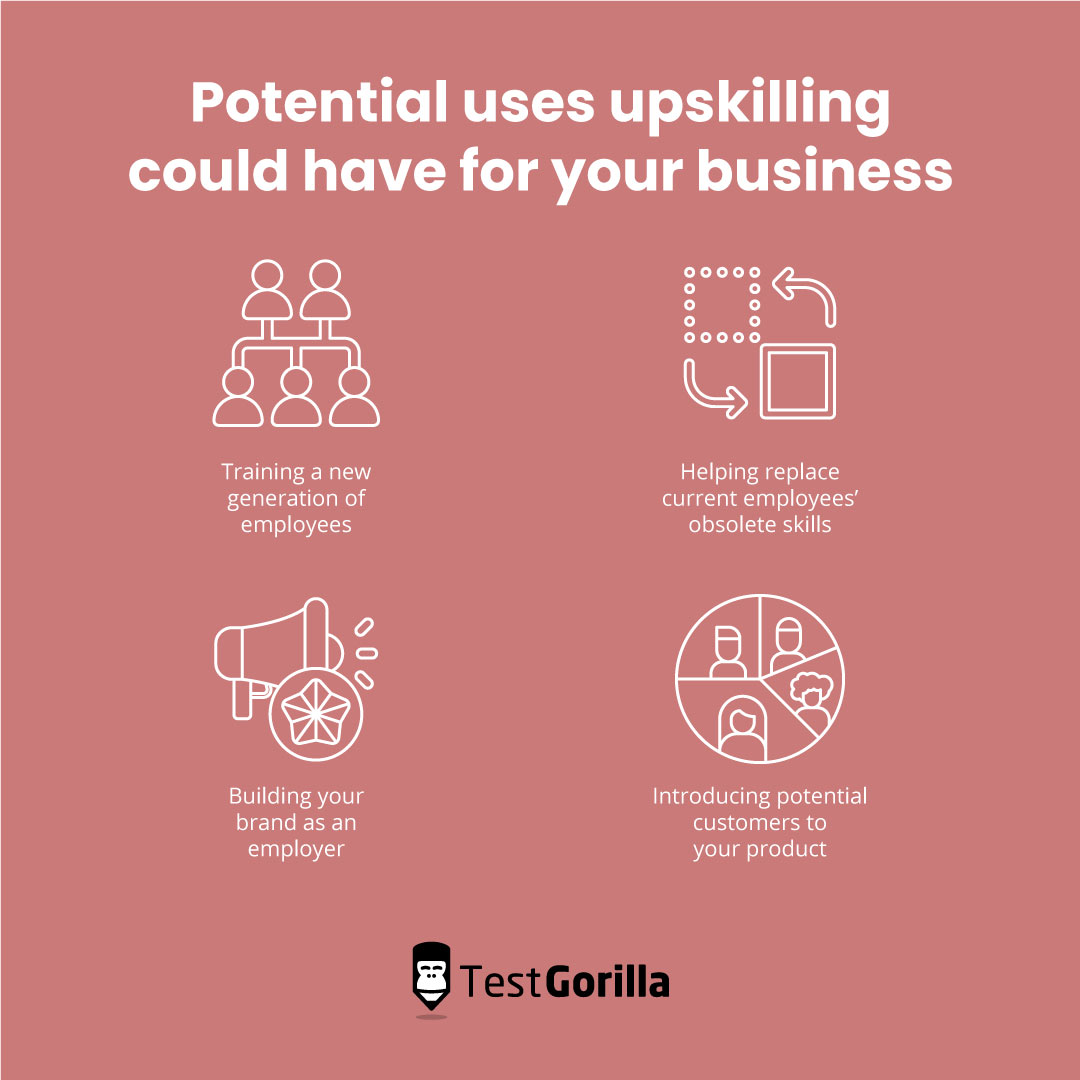You’ve probably heard the buzz about skills-based hiring. Our own research found that more than three-quarters of businesses are already using skills-based hiring methods, with over 90% seeing a reduction in mis-hires and time to hire after the switch.
But the transformation doesn’t have to stop when you’ve filled your vacancies with candidates who add to your company culture.
Investing in employee development goes hand-in-hand with the skills-based hiring approach. In fact, many organizations are now recognizing that upskilling is necessary to help their businesses survive and thrive amid current business challenges.
According to a report by LinkedIn Learning, upskilling was the number one priority for leadership and development professionals worldwide in 2021.[1] But what makes upskilling so important, and what’s driving employers across many industries to embrace it?
In this post, we’ll talk about what upskilling is, how it differs from the related practice of reskilling employees, and the benefits of upskilling initiatives for your organization, with some real-life examples.
Table of contents
What is upskilling?
Upskilling refers to when you supply employees with training to expand their skill set, usually with the goal of aiding their progression along their current career path.
Upskilling might enable an employee to take on extra responsibilities in their current role, such as a social media manager learning to use Facebook Ads, or prepare them for a higher-up position, such as a junior developer becoming a senior developer.
It’s important to distinguish between upskilling and basic on-the-job training. Where basic training simply ensures that candidates have the skills necessary to complete their jobs, upskilling is about helping them take on extra skills to exceed these requirements.
It’s also important to differentiate between upskilling employees from reskilling them – let’s break that down.
Upskilling versus reskilling
If upskilling helps employees move vertically up the rungs of their current career ladder, reskilling is about enabling them to move laterally into other roles by training them in new, though perhaps complementary, skills.
For instance, if you noticed that one of your customer service representatives wrote especially good responses to customers by email, you might help them reskill as copywriters so that they could be redeployed into your marketing team.
Reskilling has many of the same benefits as upskilling, but we’ll mainly focus on upskilling in this blog.
Why upskilling matters
It’s clear just from these short descriptions why upskilling is a good practice for businesses to incorporate. Though, what makes it not just a nice-to-have but a strategic priority for HR professionals?
We can think of several things.
Skills are becoming obsolete faster than ever before
The current rate of change in business is staggering, and not only in technology. Just think of what “business as usual” looked like three years ago compared to now: Since the pandemic, some businesses have embraced fully remote work while others have moved to a hybrid office model.
Skill requirements are also changing rapidly. Gartner reported in 2020 that the number of skills required for a single job was increasing by 10% year-on-year, while the World Economic Forum predicts that half of all workers worldwide will require reskilling by 2025.
To take an example among hiring professionals, in-person interview skills have waned in importance compared to virtual interviewing skills, thanks to the shift to remote working during the lockdown.
Indeed, the use of video interviews increased by 67% from 2020 to 2021, and although this number fell by 10% in 2022, that’s still a net increase of 57% compared to pre-pandemic times.
Upskilling can help employers replace obsolete skills with new ones and is a cheaper alternative to hiring all-new employees.
Don’t believe us? While organizations spent an average of just $1,267 per employee on training and development in 2021, the average cost of hiring a new employee in the same year was around $4,000.
This reduced shelf-life of employees’ skills could only have one outcome.
Skill shortages are at a 10-year high
Skill obsolescence has combined with the volatility in the job market right now to create massive skill shortages across sectors. In the last decade, talent shortages have more than tripled, with 69% of employers having trouble filling positions compared to 14% in 2010.
This is due to a number of factors, many of which are the knock-on effects of the COVID-19 pandemic. After laying off huge segments of their workforce during the lockdown, the need for employees returned faster than anticipated, and the shortfall was worsened by the fact that many baby boomers took early retirement in 2020.
It’s not always easy to tell where these gaps are occurring in your workforce. By performing a skills gap analysis, you can identify which teams are suffering most from these shortages, identify the skills they need to remedy them, and create an upskilling strategy to match.
However, the benefits of upskilling extend far beyond patching holes in your workforce.
Upskilling helps businesses attract and engage employees
We’ve already seen that many companies are struggling to find skilled workers to suit their open roles. We haven’t mentioned that organizations with skilled workers are experiencing an engagement crisis.
The percentage of engaged workers in the U.S. declined in 2021 – the first time this has happened in more than 10 years. Just over one-third of employees said they were engaged with their work, and 16% were completely disengaged.
Upskilling initiatives can combat the spike in employee disengagement as they represent a win-win for both employees and employers.
For employees, upskilling represents a path to career advancement. The American Upskilling Study found that employees who participated in an upskilling program saw an average salary increase of 8.6%. That’s $8,000 more than their colleagues who didn’t participate!
For employers, it boosts your employer brand. The same study found that 65% of American workers say employer-provided upskilling is very important when evaluating a new job, and nearly half (48%) say they would switch to a new job if it offered them opportunities to enhance their skills.
The impact of employee engagement cannot be underestimated, as not only are employees happier at work, but the work they produce is better.
Focusing on skills improves efficiency and innovation
An employee engaged in their work is naturally more likely to contribute to a positive workplace culture and work hard to generate new and innovative ideas.
Research from Deloitte revealed that introducing a skills focus to how you build and develop your workforce positively affects efficiency and innovation.
Companies that adopt a skills focus are:
Over twice as likely to make effective hires
57% more likely to anticipate change and respond effectively
52% more likely to innovate
This isn’t just good for your organization but for the business ecosystem at large. The World Economic Forum says that public-private collaboration on large-scale upskilling and reskilling initiatives could be key to economic recovery post-COVID, boosting GDP by a predicted $6.5tn and creating 5.3 million jobs by 2030.
What upskilling looks like in different industries
We’ve covered the basics of upskilling and the benefits it can bring to your workforce, but there are many creative ways to apply these initiatives.
Let’s look at some examples from real companies across different industries.
Finance
Providing upskilling opportunities to your current employees can boost your employer brand and make you more attractive to new hires.
However, upskilling isn’t only useful for current employees. The IBM Skills Academy targets the very top of the funnel for potential hires by providing college students with online courses and guest lectures to help them develop the skills they need to launch a career in finance.
It doesn’t just cover business fundamentals, either. The academy offers dedicated tracks in future-focused topics, including:
Artificial Intelligence
Data Science
Security
The Cloud
It’s a lesson in creating the skills you want to see in future recruits, as it’s essentially training the next generation of financiers – and, importantly, putting the IBM employer brand at the front of their minds.
E-commerce
Amazon offers a more familiar version of the upskilling initiatives we’ve discussed above but on a grand scale.
The company’s “Upskilling 2025 Pledge” committed $1.2bn for 300,000 employees to have access to education and skills training, even including college tuition for frontline employees.
Initiatives involved in the pledge include:
Amazon Technical Academy, a program that provides non-technical Amazon employees with the skills to thrive as software engineers
“Grow Our Own Talent,” an Amazon Web Service training pathway for entry-level employees from non-traditional backgrounds that provides them with on-the-job training and job placement
Career Choice, a prepaid tuition program for employees looking to further their higher education
Professional services
Deloitte University is another creative instance of an organization using upskilling to support its employees, elevate its brand, and drive a reputation for thought leadership.
Launched in 2011, Deloitte University transports Deloitte employees and clients to a learning facility in Westlake, Texas. There, they learn about cutting-edge topics using teaching techniques that range from the traditional (role-playing and case studies) to the futuristic (holograms, augmented reality, and humanoid robots).
Tech
Finally, Salesforce Trailhead is an example of an organization facilitating upskilling initiatives outside of itself as a form of marketing.
Trailhead was created to train salespeople on how to use the Salesforce platform and ecosystem to their advantage.
This isn’t just great for helping sales professionals improve their understanding of customer relationship management systems. By taking the burden of training sales teams in new software off the hands of employers, SalesForce incentivizes those businesses to adopt their products permanently.
Clearly, there are many ways in which you can deploy upskilling initiatives to suit your business strategy. Far from being just a good deed for your employees, it could be the key to unlocking growth in your organization.
Kick-start your upskilling strategy by assessing the skills of your workforce
After reading this post, you not only know why upskilling is important, but you also have an overview of all the potential uses it could have for your business. These include:
Training a new generation of employees
Helping replace current employees’ obsolete skills
Building your brand as an employer
Introducing potential customers to your product
Now, it’s time to start reaping the benefits for yourself. Begin by assessing the skills of your current employees and identifying any gaps or areas for growth.
For instance, use our Critical Thinking test to identify candidates with the potential to level up their strategy skills and highlight leadership training.
Alternatively, you might notice a junior accounting employee is progressing fast, so you’ll want to see if they’re ready to move to the next level using our Intermediate Accounting test.
Finally, once you have a clear overview of the skills at your disposal, use our upskilling guide to create a new strategy.
Sources
“Skill Building in the New World of Work”. (2021). LinkedIn Learning. Retrieved February 15, 2023. https://learning.linkedin.com/content/dam/me/business/en-us/amp/learning-solutions/images/wlr21/pdf/LinkedIn-Learning_Workplace-Learning-Report-2021-EN-1.pdf
Related posts
Hire the best candidates with TestGorilla
Create pre-employment assessments in minutes to screen candidates, save time, and hire the best talent.
Latest posts
The best advice in pre-employment testing, in your inbox.
No spam. Unsubscribe at any time.

Hire the best. No bias. No stress.
Our screening tests identify the best candidates and make your hiring decisions faster, easier, and bias-free.
Free resources
This checklist covers key features you should look for when choosing a skills testing platform
This resource will help you develop an onboarding checklist for new hires.
How to assess your candidates' attention to detail.
Learn how to get human resources certified through HRCI or SHRM.
Learn how you can improve the level of talent at your company.
Learn how CapitalT reduced hiring bias with online skills assessments.
Learn how to make the resume process more efficient and more effective.
Improve your hiring strategy with these 7 critical recruitment metrics.
Learn how Sukhi decreased time spent reviewing resumes by 83%!
Hire more efficiently with these hacks that 99% of recruiters aren't using.
Make a business case for diversity and inclusion initiatives with this data.

